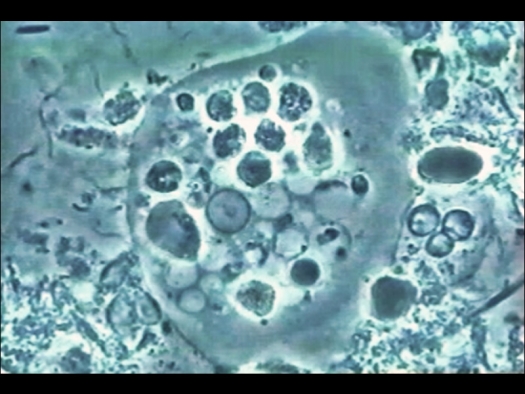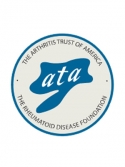EntamoebaGingivalisMicroscopyColor.jpg

Image by Mark Bonner, DMD, Institut international parodontie; Wikimedia Commons / CC BY-SA 3.0
Entamoeba gingivalis from aggressive periodontal disease patient biofilm using phase contrast microscope 1000x. It is recognizable through its dense core in the middle, formed by a central point encircled by a circular halo and surrounded by bigger phagosomes inside a greyish cytoplasm.
Introduction
The Roger Wyburn-Mason & Jack M. Blount Foundation for the Eradication of Rheumatoid Disease (The Arthritis Trust/ The Rheumatoid Disease Foundation) was founded in 1982 by a group of doctors and myself, a former rheumatoid arthritis victim. Roger Wyburn Mason, M.D, Ph.D. developed the first relatively swift means for knocking out the progress of 80 or so rheumatoid diseases, including rheumatoid arthritis. Note that this world-famous nerve surgeon (two nerve diseases named after him while still alive) was ostracized as soon as he’d announced a cure for “what everyone knows” is incurable; i.e., the rheumatoid diseases.
Dr. Wyburn-Mason’s cure was based on his uncorroborated discovery of an amoeba (Limax amoeba, described similarly to Entamoeba). Based on his presumed discovery, he developed the treatment which we still recommend as a first trial, but usually along with proper nutrition, anti-candida and food allergy treatments. This treatment has resulted in the author’s wellness, as well as thousands of others, one physician (Gus Prosch, Jr., M.D.) having achieved a 75% to 80% cure rate with his patients since 1982. Another physician (Joseph Mercola, D.O., S.C.) having also achieved the same cure rate following Thomas McPherson Brown’s treatment protocol based on mycoplasma source causation.
Dr. Wyburn-Mason’s 479 page deluxe-edition book, The Causation of Rheumatoid Disease and Many Human Cancers: A New Concept in Medicine (Iji Publishing Co., Inc. Tokyo, Japan, 1978) so meticulously recording a lifetime of clinical correlations and relationships, now out of print, is summarized in a precis’ of the same name available through this foundation.
Since that date di Fabio and Prosch (M.D.) have summarized the reports of a large number of different organisms reportedly creating the antigen/antibody reactions underlying (or simulating) the causation of rheumatoid diseases, said immunocomplexes producing a tissue sensitivity resulting in rheumatoid disease symptoms. (Arthritis: Osteoarthritis & Rheumatoid Disease Including Rheumatoid Arthritis; ISBN 97-071310, p. 196).
As a short aside, note that major textbooks used in medical schools accept two hypotheses for the causation of rheumatoid disease: (1) there’s something wrong with the immune system, as portions of its defenses attack one’s own tissues; (2) tissue sensitivity resulting in manifestations of the symptoms of rheumatoid disease derive from the toxins or protein products of invasive microorganisms.
Virtually all research funding, amounting to billions of dollars, is and has been spent on the first hypotheses, resulting, to date, in total failure to achieve wellness. Dr. Roger Wyburn-Mason’s work (amoeba source), as well as that of Dr. Thomas McPherson Brown (mycoplasma source) are the only two treatment directions that have consistently resulted in cures -- and both of these were by individuals who persisted, by their own funding, against hosts of well-financed naysayers.
One of the major sources for the development of toxins leading to tissue sensitivity that results in rheumatoid disease symptoms is the root canal, whenever (1) teeth have been extracted, or (2) prior root canal work has been completed.
Originally sponsored by the American Dental Association, Dr. Weston Price over a period of 25 years had up to 60 leading physicians, dentists, and scientists working on determination of numerous disease-causing organisms that had mutated from aerobic to anaerobic forms after tooth extraction or root canal work. Locked in the root canal, Price and associates reported that microorgansims produced deadly toxins daily affecting other bodily tissues and resulting in a multiplicity of degenerative diseases.
All this splendid research is buried in the library archives of the American Dental Association, one copy also located at the Price-Pottenger Nutrition Foundation (P.O. Box 2614, La Mesa, CA 91943-2614; (619) 462-7600).
George E. Meinig, D.D.S., one of the founders of the American Association of Endodontists (root canal therapists) summarizes Dr. Price’s work in Root Canal Coverup.
The Microbiology of Periodontal Infections: Oral and Systemic Implications
The Case for the Pathogenicity of the Oral Protozoa
by Trevor Lyons, B.D.S. (Lond.), L.D.S., R.C.S. (England), R.M. (C.C.M.) Dentist and Microbiologist
Used by permission from Introduction to Protozoa and Fungi in Periodontal Infections: A Manual of Microbiological Diagnosis and Nonsurgical Treatment. Copyright 1989: Trevor Lyons, (ISBN 0-9693950-1-9). “Lecture based on data found in above manual, said manual intended for dentists and other health professionals, including researchers, but should not be beyond the comprehension of any well read lay person.” ~ Trevor Lyons
A common finding was the incidence of a new infection with Entamoeba gingivitis and the development of general malaise or “flu-like” symptoms. This phenomenon may indicate a sudden release of virus and/or other antigenic material. Systemic disturbance, which may be loosely described as “flu,” is sometimes noted following routine dental procedures. I was taught to regard this as just a coincidence. However, at the outset of these investigations, all such occurrences following dental procedures were found to have affected only those patients already infected with Entamoeba gingivalis. This might indicate that dental procedures, such as the use of high speed water-cooled instruments, could produce an infective aerosol spray which the patient could inhale with unfortunate consequences. If so, this would also imply considerable risk for the operator.
Since Entamoeba gingivalis is about the same size as blood cells on which it feeds, instrumentation around a site infected with protozoa could also produce a parasitaemia. It is not surprising. then, to find that Snyderman & McCarty. (Duke University Medical Center) report similar pathology in rheumatoid arthritis and destructive periodontal disease. A correlation between arthritis and oral amoebiasis has been observed. Over fifty years ago Kofoid reported finding entamoeba in the bone marrow of some arthritic subjects. This would help explain the historical relationship between arthritis and periodontal diseases and a vogue for treating arthritis with anti-protozoal drugs. I find, in the treatment of periodontal disease, that following the elimination of Entamoeba gingivalis, some patients with arthritis report a dramatic reduction in signs and symptoms of the disease. This improvement is usually maintained unless the patient becomes reinfected.
One patient with periodontal disease had arthritis but no amoebae in the mouth. Stool sampling was positive for an intestinal protozoan. Endolimax nana. A course of anti-protozoal medication brought an improvement in his periodontal condition, his arthritic symptoms and his digestion. Obviously, then, all, periodontal disease does not have the same cause, nor does periodontal disease cause all arthritis, but there appears to be a link between oral and systemic disease for some patients.
Although Entamoeba gingivalis has been known for 149 years, and the evidence to support it being labelled as a pathogen has been steadily growing since the early nineteen hundreds, there still appears to be some who doubt the pathogenic nature of Entamoeba gingivalis.
This is not surprising when one observes statements by investigators in the same jurisdictions who contradict each other. Thus in 1978 Kikitina in Moscow stated that the cause in Moscow of periodontal disease was unknown. Meantime in Kiev, two years earlier, Musaev and coworkers had published their findings which correlated the incidence of oral parasites as pathogens in periodontal disease.
Copyright 1997. All rights reserved by The Roger Wyburn-Mason and Jack M. Blount Foundation for the Eradication of Rheumatoid Disease AKA The Arthritis Trust of America.® The Rheumatoid Disease Foundation / The Arthritis Trust of America was dissolved in 2020 and all website content was transferred to the Foundation for Alternative and Integrative Medicine.


